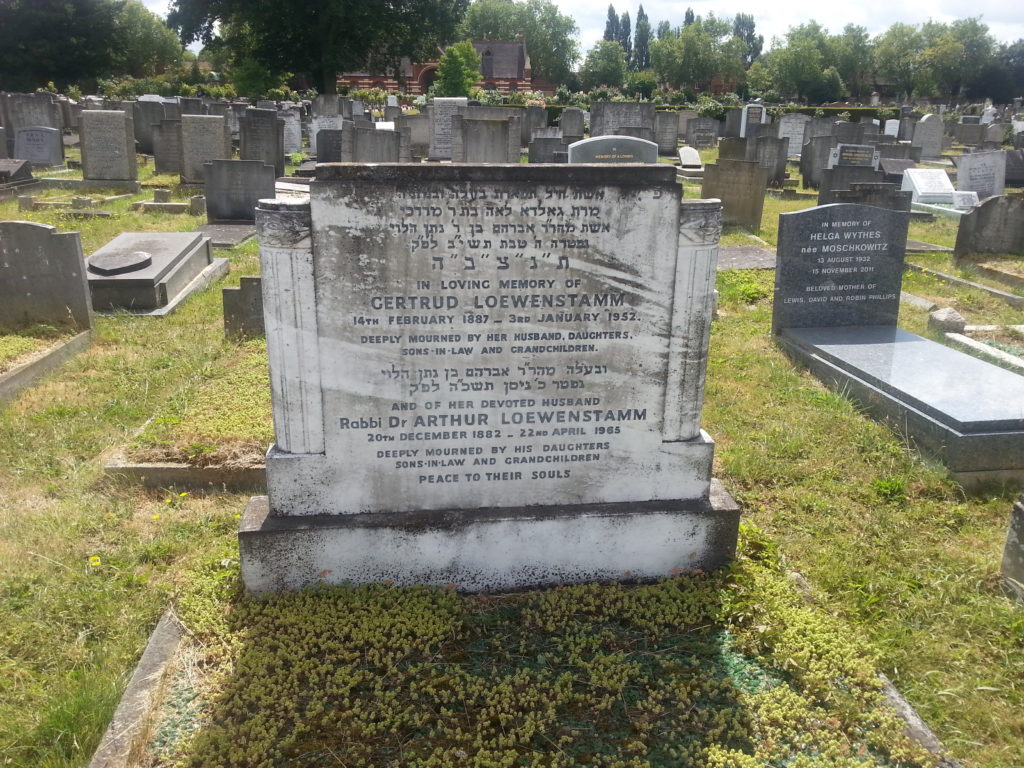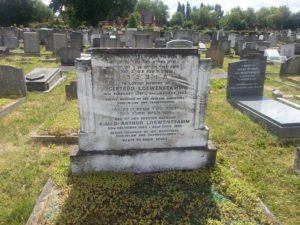A Learning Day Out

Learning is central to the museum’s values and here in the Learning Team we like to practice what we preach! This means that twice a year we book a full day of CPD and off we go to learn something new. With the school summer holidays just starting and new staff joining the team these past few months now was the perfect time – Frances Jeens- Head of Learning
Shereen Hunte- Learning Officer
Our first stop was to Hoop Lane Cemetery. Founded in the late 19th Century, Hoop Lane was one of the first Jewish spaces to be established in Golders Green (before the mass migration of the Jewish community and before the arrival of the tube station!) Rachel Kolsky took us on a tour around the cemetery, starting with a wall of tributes to 12 Kindertransport Rescuers including Nicolas Winton, Frank Foley and Ho Feng Shan. To the right of the cemetery were tombstones which lay flat as is a tradition of Sephardi graves whilst to the left, the headstones which commemorated members of the Reform Community stood up tall. Throughout the cemetery, many of the tombstones were scattered with pebbles and rocks left by family members. Pebbles, unlike flowers, cannot wither away.
In the Sephardi side of the cemetery were the graves of the parents of the Iraqi Jewish Saatchi brothers, founders of the advertising agencies Saatchi and Saatchi. Nearby, were also the graves of Jackie and Joan Collins’ parents. In the Reform part of the cemetery, certain tombstones reflected similar symbolism as found on Christian gravestones such as slashed columns to resemble a life lost too soon. This was a result of the largely Christian tombstone makers of the time. In the Reform part of the cemetery were the graves of artist Rose Louise Henrique and her husband Sir Basil Quixano Henriques, philanthropist and founders of many boys’ clubs for deprived for Jewish children.
Emma Weleminsky-Smith- Learning Officer
I felt very privileged to be able to visit the graves of some of my great grandparents at the cemetery and share their stories.
Dr Freidrich Weleminsky, my maternal grandfather’s father, was a talented scientist who created an early cure for tuberculosis called Tuberculomucin Weleminsky while working as a member of the medical faculty of the German University in Prague. This cure was about to begin commercial production when the war broke out and Freidrich fled with his wife and two of his children to the UK. My mother, Judy Weleminsky, is working at the Royal Free Hospital (in connection to UCL) to try and recreate this cure using Freidrich’s notes.
Rabbi Dr Arthur Löwenstamm, my maternal grandmother’s father, worked as a community rabbi in several synagogues and was the last rabbi of the community of Spandau, Berlin. His synagogue was set on fire during Kristallnacht and he was sent to Sachsenhausen Concentration Camp. Thankfully he was able to come to the UK in 1939 and ended up teaching at Leo Baeck College (Progressive rabbinical school) and taught, among others, Rabbi Hugo Gryn. In 2002 a street in Spandau was named Löwenstamm Street.
Lisa Shames- Learning Manager: Families, Interfaith and Community
Arguably, the most important part of a Jewish Culture CPD day is lunch. We decided to head over to Hummus Bar on Golders Green road. The first part of the menu listed their signature homemade hummus, made twice daily. The hummus can be ordered plain or topped with any number of delicious items such as falafel, grilled mushrooms, salt beef, spicy beef, or even a sloppy joe version with minced beef, mushrooms and egg. The menu also featured various salads, sides and mains including schnitzel, sabich, burgers and brisket.
Seeing as hummus is the signature dish, all nine of us decided to dip right in….
I ordered the Oriental Beef Hummus topped with spiced minced beef and caramelised onions. The hummus arrived with warm pita and a spicy chili sauce. The hummus was deliciously creamy, dusted with paprika, and drizzled with extra virgin olive oil and red tahini. The beef was perfectly spiced with warm Moroccan spices while the caramelised onions added a bit of sweetness. I honestly cannot express just how smooth, creamy and delicious everything was–only that I will definitely be back many times to work my way through this gorgeous menu!
Emily Barnes- Learning Officer
 Following lunch, we headed off along Golders Green Road to explore the bakeries and shops. Every year we review our handling collection for our school workshops and this was a chance to add to it. Jerusalem the Golden was full of unusual treasures, many of which I had never seen or heard of before – children’s toys and books to help learn Hebrew, Kippot for every occasion and beautiful items of Judaica. For me, visiting the shops was quite eye-opening, revealing a world of items I had never imagined, it was quite incredible to see all these objects together and the sense of community that came with that. Take a look at some of the items we choose to add to our collection.
Following lunch, we headed off along Golders Green Road to explore the bakeries and shops. Every year we review our handling collection for our school workshops and this was a chance to add to it. Jerusalem the Golden was full of unusual treasures, many of which I had never seen or heard of before – children’s toys and books to help learn Hebrew, Kippot for every occasion and beautiful items of Judaica. For me, visiting the shops was quite eye-opening, revealing a world of items I had never imagined, it was quite incredible to see all these objects together and the sense of community that came with that. Take a look at some of the items we choose to add to our collection.
Emma Crew- Learning Assistant
 We then visited SOFERSTaM. I was really excited to go here as they have kindly donated many objects to our handling collection including quills and scrolls. Our schools children are really interested in these objects and the process by which Siffrei Torah are made and repaired. It was fascinating to see where this careful work is done. On our visit, we were fortunate enough to see a large Sephardi Torah in the process of being repaired.
We then visited SOFERSTaM. I was really excited to go here as they have kindly donated many objects to our handling collection including quills and scrolls. Our schools children are really interested in these objects and the process by which Siffrei Torah are made and repaired. It was fascinating to see where this careful work is done. On our visit, we were fortunate enough to see a large Sephardi Torah in the process of being repaired.
We then went to Kosher Kingdom. Our museum regularly buys items from here in preparation for different festivals. This was my first time visiting and it was great to see such a wide range of items relating to the Jewish faith. We bought some more Havdallah candles for our handling collection. Shabbat is a popular topic with schools with 3,077 students coming to our museum to learn about it last year! We also bought some bamba to try a traditional Israeli snack- it was very popular with the team.
Charlotte Hafner- ARSP intern
 At the end of our CPD trip we enjoyed some cold drinks at Head Room Café. This lovingly decorated café was opened by Jami, a mental health service for the Jewish community, as a space for taking a relaxing time out from the troubles of everyday life. Jami’s aim is to create opportunities for Jewish people living with mental illnesses, enable them to take on the journey of recovery and work on reducing the stigma and prejudice surrounding topics of mental health. We really enjoyed our time at the Head Room Café, and their Homemade Limonana definitely became a particular favourite of the team.
At the end of our CPD trip we enjoyed some cold drinks at Head Room Café. This lovingly decorated café was opened by Jami, a mental health service for the Jewish community, as a space for taking a relaxing time out from the troubles of everyday life. Jami’s aim is to create opportunities for Jewish people living with mental illnesses, enable them to take on the journey of recovery and work on reducing the stigma and prejudice surrounding topics of mental health. We really enjoyed our time at the Head Room Café, and their Homemade Limonana definitely became a particular favourite of the team.

